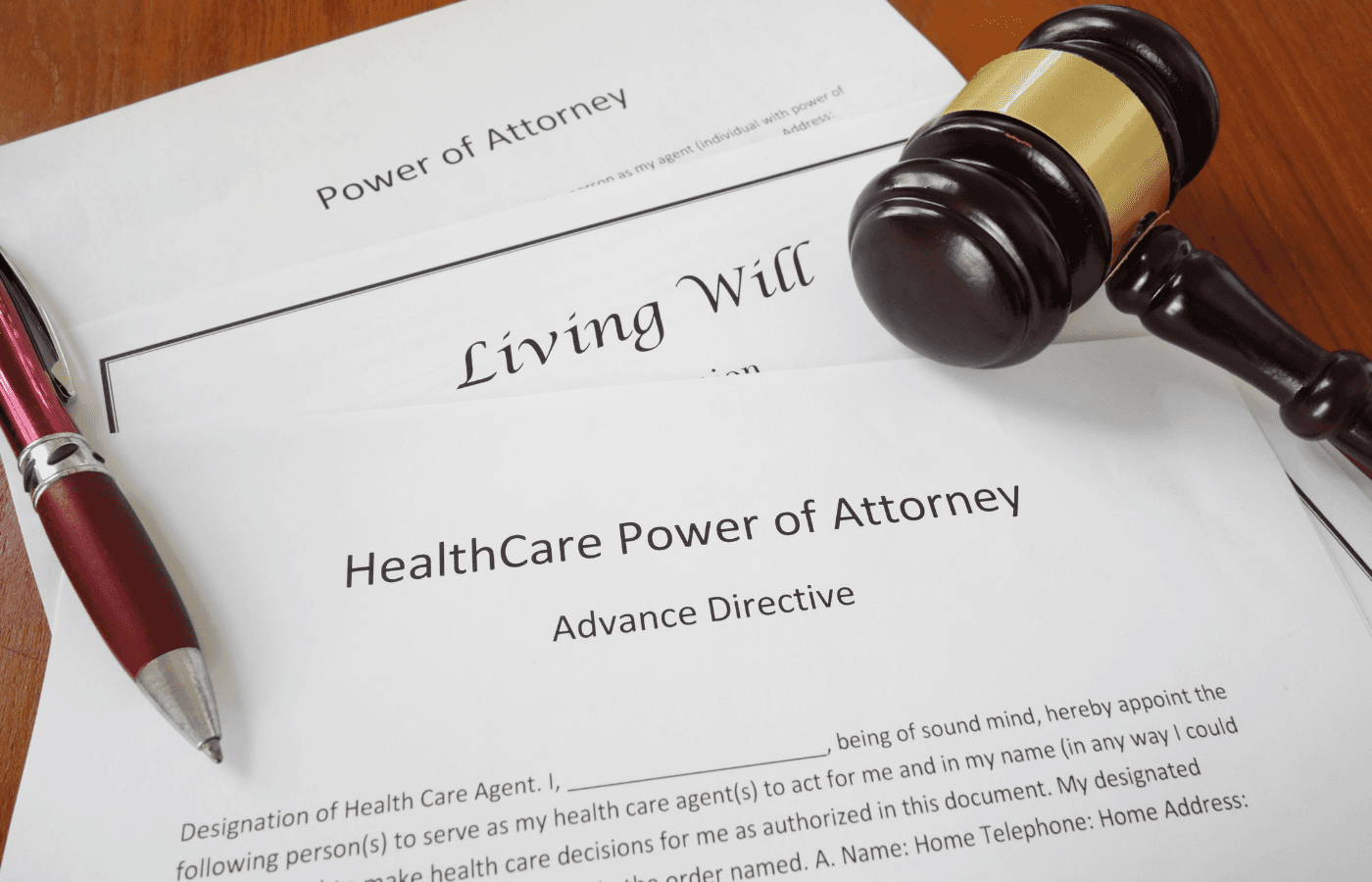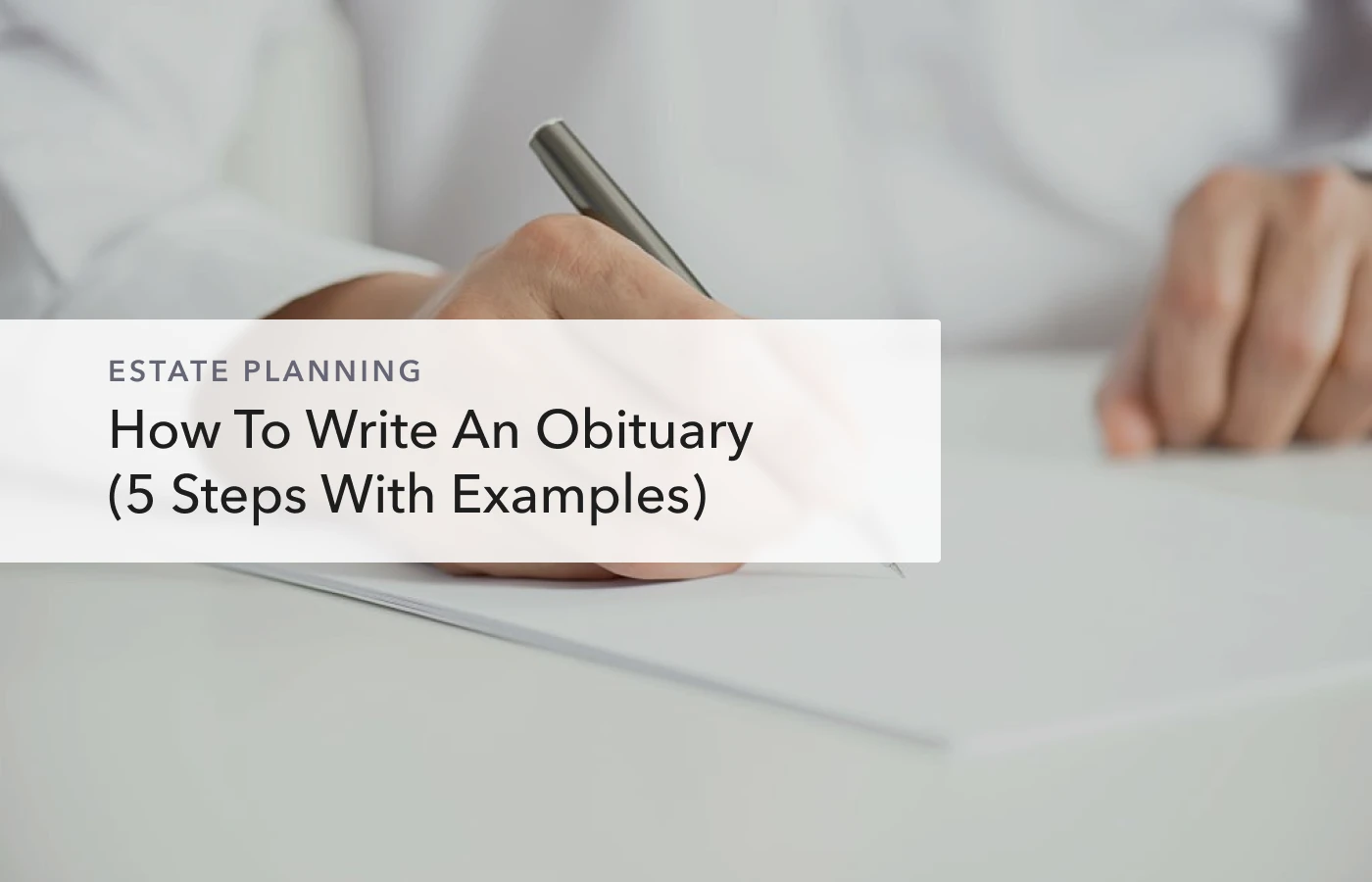Estate Planning
Estate Planning: A Comprehensive Guide


Kris Kopac
May 17, 2023
Do you have an estate plan?
Estate planning, or end-of-life planning, is one of the most important things you can do for yourself and your family.
Your estate plan is a roadmap for who will take care of your children and/or pets and who will inherit the assets you worked so hard to accumulate when you pass on. Estate plans can also dictate who will make decisions about your medical care if you are unable to make decisions for yourself. Without an estate plan, the laws and courts in your state will make some of those decisions for you, and they may not know your wishes.
End-of-life planning is essential for everyone. However, estate planning is also one of the easiest things to put off, because no one likes thinking about what will happen after they die. In fact, a study by AARP found that nearly 60% of American adults don’t have a will or living trust.
We know that it can be tough to get started on end-of-life planning. That’s why we put together this simple guide for you. We will walk you through the basics of estate planning step-by-step.
What is an estate plan?
Simply put, an estate plan is a guide for your loved ones, trusted professionals, and the courts to make sure that your wishes are fulfilled when you pass away or are incapacitated.Your “estate” is all of your property and assets, including your home, personal property, financial assets, family heirlooms, valuables, and even digital currency.An estate plan consists of multiple different documents that cover how to distribute those assets, who will care for your dependents, and how to manage your healthcare emergencies.The specific documents and pieces of your estate plan will vary according to your family, situation, priorities, finances, and the state you live in.
Do I need an estate plan?
Yes! Every adult should have an estate plan, even if you have no children or assets.
If you die without a will (dying intestate), the state will step in to decide what happens to your assets and who your heirs are. Your assets could be tied up in probate court. This process adds time, stress, and additional costs for your loved ones, and could leave a very different legacy than the one you would choose.
It is particularly important to have an estate plan if you have:
A spouse: In many cases, your spouse will inherit your possessions if you die without a plan, but that is not always guaranteed. Your estate plan makes sure that your spouse receives the support they need.
Kids, pets, or other dependents: you need an estate plan to specify who will be your dependents’ guardian if something happens to you. Your estate plan can also designate funds for their care.
Why do I need an estate plan?
Among many other benefits, your estate plan can:
Allow you to choose who inherits specific assets, possessions, and other valuables.
Reduce the time and cost it takes for the courts to settle your estate.
Name guardian(s) for your dependents.
Reduce family conflicts over your estate.
Help you reduce taxes on your estate for your heirs.
Outline a plan for your funeral to reduce stress on your loved ones while they are grieving.
Designate someone you trust to make medical decisions for you if you cannot make them for yourself.
Assign a loved one or trusted advisor to manage your finances if you cannot manage them independently.

Organize your estate documents in Trustworthy.
How to make an estate plan
Step 1: Decide whether to bring in an expert.
The first step in creating an estate plan is deciding whether to bring in professionals like an estate planning attorney or a financial advisor to help. These experts can help you manage more complex estates and ensure that everything in your plan is airtight.
While everyone would benefit from working with estate planning experts, you would particularly need professional support if you:
Own a vacation home or other property in a different state.
Have a partner with whom you aren’t legally married.
Have a divorce or custody agreement in place.
Remarried or have a blended family — especially if you have children.
Prefer that someone does (or doesn’t) get access to you at the hospital.
Are concerned about state or federal estate and gift taxes.
If you use Trustworthy, you can add your attorney and financial advisor to your Trustworthy account to collaborate on your estate plan. Our expert team can also help you gather paperwork or documents to share with your estate planning attorney.

Add a new collaborator in Trustworthy
Step 2: Make a list of your physical possessions
Before you can decide what will happen to your possessions, you need to make sure that you are accounting for all of them.
You should list everything of value, including your home (if you own it), vehicles, jewelry, art, antiques, family heirlooms, computers, tvs, power tools, and other electronics.

Property category in Trustworthy
Are you overwhelmed by the idea of trying to find all your property and assets? Trustworthy is here to help. Instead of starting with a blank page, our AI creates a customized template for you to inventory your possessions.

Organize property details
Even better, you can add important information that your loved ones will need to know about the property, from account numbers to family stories. Simply sign into Trustworthy, go to the Property tab, and start filling in your template.
Step 3: List your digital possessions
Our lives are increasingly lived in the digital as well as the physical world. As such, estate planning has to take your digital assets and life into account.
Put together a list of all your email and social media accounts, cryptocurrency, money transfer apps (like PayPal and Venmo), and important passwords.
Most of your digital estate plan should be kept out of your will. Your will becomes public after you die, and it would not be good for your important passwords and accounts to end up in the hands of nefarious strangers. The digital world also changes faster than the physical world, and you don’t want to have to update your will every time you change a password or create a new account.
You can list your important digital accounts and passwords in the Passwords section of Trustworthy, or find a secure location where your family members can access the information.
Step 4: List your debts
Next, it is time to inventory all of your debts, from credit cards to mortgages, personal loans, auto loans, and private student loans.
In your list, you should add account numbers, contact information for the companies, and where to find any related documents or agreements.

Connect financial accounts with Plaid
Trustworthy makes this process easy. In the Money tab, you can enter credit cards and loans. With your permission, Trustworthy can automatically pull in your account information with Plaid and add the company’s contact information.
Once you are finished with your list of debts, make copies of your lists of assets and debts for your estate planning experts, your executor, and your partner. You can also invite them as collaborators to your Trustworthy account.
Step 5: Check and update the beneficiaries on your retirement accounts and insurance policies.
An essential part of estate planning is checking and updating the beneficiaries on your financial accounts and insurance policies. If you have designated a beneficiary, the account will pass on to them no matter what your will says about how your assets will be divided.
Many accounts will allow you to update your beneficiaries online. However, if your 401k account or life insurance is provided through work, you may have to contact your company’s plan administrator to check and update your beneficiaries.
Step 6: Choose an executor and guardians (if you have children)
The next step is to choose your executor. An executor is a person who is selected to manage the execution of your last will and testament and make sure that your wishes are carried out.
Executing a will can take dozens of hours of phone calls, paperwork, and diligence and years of work. For that reason, it is important to choose an executor who has the administrative and organizational chops to get things done.
Some people choose not to name a close family member as the executor of their will because they understand the emotional pain this task may cause. Whatever you decide, you should inform your chosen executor of your decision and ask them if they’re able to take on the role, as it is a big commitment on their end.
You can name more than one executor. However, it is important to note that your executors would have to make all decisions unanimously, which might be difficult in such a challenging time. If you name more than one executor, every executor must co-sign paperwork.
It’s also a good idea to name someone as a backup, in case your first choice isn’t able to perform the duties.
Step 7: Create a will.
Once you have your lists of assets and debts and your executor in place, it is time to start creating the documents in your estate plan. We recommend that you start with your will, the centerpiece of your estate plan.
Many lawyers will help you create a will for less than $1,000.
You can also work with online companies like FreeWill and Trust&Will to create your own. (Pro tip: you can access exclusive discounts on these and other services through the Trustworthy marketplace and earn credit toward your Trustworthy membership!)
Your will should include:
Assets and property - the property and assets you are passing on to your loved ones, from your 401(k) and your house deed to grandpa’s favorite watch.
Beneficiaries - the people who will inherit your property and assets.
Custodian/Trustee - an adult custodian who is named to manage money in a trust account on behalf of a beneficiary who is a minor.
Executor - Someone to manage your will and close your estate. An executor is also called an administrator or personal representative
Guardian - the person/people selected to take care of your kid(s) and pet(s).
Instructions on finances, distribution of money, and paying debts.
Additional funeral or burial instructions.
Gifts to individuals or charities.
Once you have drafted your will with your lawyer or an online service, it is time to sign and notarize it. Although a probate judge may adhere to the instructions of an unsigned will if there is reason to believe it represents your true intentions, an unsigned will is not sufficient proof of your intentions. There is no guarantee that your wishes will be carried out if your will is unsigned.
It is standard procedure to sign your will in the presence of two witnesses. They will also sign your will to validate it.
Signing your will with your two witnesses and a notary present is an additional safeguard to ensure your will is legally binding, although it isn’t required in most states. You can usually find a free notary service at your bank or credit union, and some UPS stores offer notary services for a nominal fee. You could work with a mobile notary who will travel to your office or home for an additional fee.
An increasing number of states have legalized online notary services, but you should check your state’s laws before getting your will notarized online.
Step 8: Complete your estate plan.
With your will completed, it’s time to finish the other documents in your estate plan.
We will cover how to create two of the most common documents: a power of attorney and a living will (advance healthcare directive). As with your last will and testament, your estate planning attorney can also help you create these documents, or you can work with an online service.
Create a power of attorney (POA)
The power of attorney (POA) document names specific people who will take care of important matters - such as financial and medical decisions - on your behalf while you are alive. After you have passed away, the POA is revoked and your will becomes effective.
In your power of attorney, you do not have to choose only one person to take care of your affairs while you are unable to make decisions for yourself. In fact, you should name a backup person for each role in case your first choice isn’t able to carry out their responsibilities.
The different powers of attorney include:
Executive power of attorney
An executive POA takes the lead in managing big decisions on your behalf. If you have named several different POAs, this person will do their best to ensure your wishes are being carried out by the team you chose. If you don’t name POAs for different roles, the executive POA will cover all these roles. Once you die, the executor of your will takes over managing your wishes.
Medical power of attorney
A medical POA advocates for you when you are unable to communicate your medical preferences or provide consent for procedures. For example, if you are in the hospital with a severe injury that has caused you to lose consciousness, a medical POA will step in to advocate for you. The medical POA does not apply to end-of-life decisions. Designating a medical POA is not the same as completing a living will, which we will discuss in the next section.
Financial power of attorney
A financial POA manages your personal accounts. An accountant can provide an annual review to manage your bank accounts, or your executive POA can hire a professional to manage your bookkeeping, file taxes, and review statements.
Digital power of attorney
For many, our administrative lives now center around digital accounts. A digital POA is granted access to your online and digital accounts to help needed transactions run smoothly.
In order to make your digital POA’s tasks more easy and accessible, consider granting them access to a password manager so they are able to log into the necessary accounts. For example, if your executive POA has access to your Trustworthy account, they can share your password information with your digital POA.
Create a living will (advanced care directive)
A living will (also known as an advance directive, healthcare directive, declaration, or directive to physicians) records your wishes around end-of-life care if you are unable to speak for yourself. It is state-specific and legally binding.
As with your last will and testament, it is important to make a living will in advance. Once you actually need a living will, it is too late to create one.
What to include in your living will
A living will should be as specific as possible because very few medical decisions are cut-and-dried. Clearer guideposts about the types of medical care you do and do not want to receive will help remove some of the uncertainty in end-of-life decisions for your loved ones.
What does your quality of life mean to you? Answering that question in your living will helps your medical POA speak for you. The more specific your answer, the better.
A living will may answer questions around whether you do/do not want to receive:
Antibiotics
Cardiac resuscitation
Invasive diagnostic tests or procedures
Mechanical respiration
Kidney dialysis
Tube feeding
Experimental medical procedures
A living will requires witness signatures and sometimes notarization, depending on the state in which you live. Some states also do not allow the following people to act as your witness:
Someone who may inherit part of your estate
Someone named in your last will and testament
A relative by blood or marriage
You can find a notary at your bank, credit union, library, county clerk’s office, or local UPS store. An increasing number of states will also let you use online notary services, but you should check the law in your home state before working with an online notary.
Step 9: Give your executor a copy of your estate documents
Your estate plan documents are finished; great work! You have made it to the last step. Now, it is time to make sure that the people you have chosen to manage your affairs have the information they need to do so.
Make copies of your estate plan documents and give them to your executor and POAs. You should also tell them and the other people named in your will where your original will is stored.
The location that you choose for your original estate documents should be secure. Keep your original estate documents with your attorney, or in a safe spot with other important information.

Connect financial accounts with Plaid
If you use Trustworthy, you can complete this step with a few clicks of a button. Simply upload your plan into the Estate Documents section of Trustworthy, and invite your executor and POAs as collaborators in your account.
How often to update an estate plan
Now that your estate plan is completed, all the work is done, right?
Not quite. You have finished the most time consuming and difficult part of estate planning, but you still need to make sure that your plan changes as life does. You should review your estate plan at least once every four years to make sure it reflects your current wishes and assets.
You should also update your plan after life-changing events, like getting married or divorced or having a child.
Finally, you should keep an eye on financial legislation and changes to tax laws that could affect your estate and change your plan accordingly. If you have worked with a financial advisor or estate planning attorney, they can help you figure out when these changes might require you to update your estate.

Trustworthy reminders save members time and money.
No need to set a calendar reminder. If you add your estate plan to Trustworthy, we will add an automated reminder for you to review and update your estate plan regularly. We remember so you don’t have to.
What documents are part of an estate plan?
There are three main documents that frequently included in estate planning: a last will and testament, a power of attorney, and a living will (or “advance care directive”).
Depending on your circumstances, you may want or need to make additional documents part of your estate plan. We have included the most common ones.

Adding a will to Trustworthy.
Last will and testament
Who gets which family heirlooms? How will your financial assets be divided? Who will take care of your children or pets? These are all crucial answers that a will provides for those you leave behind.
Your last will and testament, or will, is the centerpiece of your estate plan. Wills are state-specific, legally binding documents that state your wishes and instructions on subjects like who will inherit your possessions and how to care for your dependents.
Many lawyers will help you create a will for less than $1,000. You can also work with online companies like FreeWill and Trust&Will to create your own. (Pro tip: you can access exclusive discounts on these and other services through the Trustworthy marketplace and earn credit toward your Trustworthy membership!)
Power of attorney (POA)
A power of attorney is a legally binding document that allows you to name people to make key decisions for you if you are incapacitated. You can name several people in your POA document to handle specific situations, such as college funds or childcare.
Living will (advanced care directive)
A living will records your end-of-life wishes about what types of medical care you do (or do not) want if you are unable to speak for yourself.
Healthcare proxy
A document that names someone to make medical decisions for you if you are incapacitated.
Letter of instruction
A document that covers informal estate information that isn’t addressed in your will. The letter could include a last message for your loved ones, details on where to find the possessions in the will, or funeral plans.
Beneficiary designation
Forms that allow you to transfer assets like financial accounts, retirement accounts, or life insurance policies directly to the recipient, regardless of the terms in your will.
Trust
A legal arrangement where a third party (trustee) holds assets on behalf of your beneficiaries. Trusts have a few benefits in addition to your will: they can specify how and when your assets pass to your beneficiaries.
Estate Planning
Estate Planning: A Comprehensive Guide


Kris Kopac
May 17, 2023
Do you have an estate plan?
Estate planning, or end-of-life planning, is one of the most important things you can do for yourself and your family.
Your estate plan is a roadmap for who will take care of your children and/or pets and who will inherit the assets you worked so hard to accumulate when you pass on. Estate plans can also dictate who will make decisions about your medical care if you are unable to make decisions for yourself. Without an estate plan, the laws and courts in your state will make some of those decisions for you, and they may not know your wishes.
End-of-life planning is essential for everyone. However, estate planning is also one of the easiest things to put off, because no one likes thinking about what will happen after they die. In fact, a study by AARP found that nearly 60% of American adults don’t have a will or living trust.
We know that it can be tough to get started on end-of-life planning. That’s why we put together this simple guide for you. We will walk you through the basics of estate planning step-by-step.
What is an estate plan?
Simply put, an estate plan is a guide for your loved ones, trusted professionals, and the courts to make sure that your wishes are fulfilled when you pass away or are incapacitated.Your “estate” is all of your property and assets, including your home, personal property, financial assets, family heirlooms, valuables, and even digital currency.An estate plan consists of multiple different documents that cover how to distribute those assets, who will care for your dependents, and how to manage your healthcare emergencies.The specific documents and pieces of your estate plan will vary according to your family, situation, priorities, finances, and the state you live in.
Do I need an estate plan?
Yes! Every adult should have an estate plan, even if you have no children or assets.
If you die without a will (dying intestate), the state will step in to decide what happens to your assets and who your heirs are. Your assets could be tied up in probate court. This process adds time, stress, and additional costs for your loved ones, and could leave a very different legacy than the one you would choose.
It is particularly important to have an estate plan if you have:
A spouse: In many cases, your spouse will inherit your possessions if you die without a plan, but that is not always guaranteed. Your estate plan makes sure that your spouse receives the support they need.
Kids, pets, or other dependents: you need an estate plan to specify who will be your dependents’ guardian if something happens to you. Your estate plan can also designate funds for their care.
Why do I need an estate plan?
Among many other benefits, your estate plan can:
Allow you to choose who inherits specific assets, possessions, and other valuables.
Reduce the time and cost it takes for the courts to settle your estate.
Name guardian(s) for your dependents.
Reduce family conflicts over your estate.
Help you reduce taxes on your estate for your heirs.
Outline a plan for your funeral to reduce stress on your loved ones while they are grieving.
Designate someone you trust to make medical decisions for you if you cannot make them for yourself.
Assign a loved one or trusted advisor to manage your finances if you cannot manage them independently.

Organize your estate documents in Trustworthy.
How to make an estate plan
Step 1: Decide whether to bring in an expert.
The first step in creating an estate plan is deciding whether to bring in professionals like an estate planning attorney or a financial advisor to help. These experts can help you manage more complex estates and ensure that everything in your plan is airtight.
While everyone would benefit from working with estate planning experts, you would particularly need professional support if you:
Own a vacation home or other property in a different state.
Have a partner with whom you aren’t legally married.
Have a divorce or custody agreement in place.
Remarried or have a blended family — especially if you have children.
Prefer that someone does (or doesn’t) get access to you at the hospital.
Are concerned about state or federal estate and gift taxes.
If you use Trustworthy, you can add your attorney and financial advisor to your Trustworthy account to collaborate on your estate plan. Our expert team can also help you gather paperwork or documents to share with your estate planning attorney.

Add a new collaborator in Trustworthy
Step 2: Make a list of your physical possessions
Before you can decide what will happen to your possessions, you need to make sure that you are accounting for all of them.
You should list everything of value, including your home (if you own it), vehicles, jewelry, art, antiques, family heirlooms, computers, tvs, power tools, and other electronics.

Property category in Trustworthy
Are you overwhelmed by the idea of trying to find all your property and assets? Trustworthy is here to help. Instead of starting with a blank page, our AI creates a customized template for you to inventory your possessions.

Organize property details
Even better, you can add important information that your loved ones will need to know about the property, from account numbers to family stories. Simply sign into Trustworthy, go to the Property tab, and start filling in your template.
Step 3: List your digital possessions
Our lives are increasingly lived in the digital as well as the physical world. As such, estate planning has to take your digital assets and life into account.
Put together a list of all your email and social media accounts, cryptocurrency, money transfer apps (like PayPal and Venmo), and important passwords.
Most of your digital estate plan should be kept out of your will. Your will becomes public after you die, and it would not be good for your important passwords and accounts to end up in the hands of nefarious strangers. The digital world also changes faster than the physical world, and you don’t want to have to update your will every time you change a password or create a new account.
You can list your important digital accounts and passwords in the Passwords section of Trustworthy, or find a secure location where your family members can access the information.
Step 4: List your debts
Next, it is time to inventory all of your debts, from credit cards to mortgages, personal loans, auto loans, and private student loans.
In your list, you should add account numbers, contact information for the companies, and where to find any related documents or agreements.

Connect financial accounts with Plaid
Trustworthy makes this process easy. In the Money tab, you can enter credit cards and loans. With your permission, Trustworthy can automatically pull in your account information with Plaid and add the company’s contact information.
Once you are finished with your list of debts, make copies of your lists of assets and debts for your estate planning experts, your executor, and your partner. You can also invite them as collaborators to your Trustworthy account.
Step 5: Check and update the beneficiaries on your retirement accounts and insurance policies.
An essential part of estate planning is checking and updating the beneficiaries on your financial accounts and insurance policies. If you have designated a beneficiary, the account will pass on to them no matter what your will says about how your assets will be divided.
Many accounts will allow you to update your beneficiaries online. However, if your 401k account or life insurance is provided through work, you may have to contact your company’s plan administrator to check and update your beneficiaries.
Step 6: Choose an executor and guardians (if you have children)
The next step is to choose your executor. An executor is a person who is selected to manage the execution of your last will and testament and make sure that your wishes are carried out.
Executing a will can take dozens of hours of phone calls, paperwork, and diligence and years of work. For that reason, it is important to choose an executor who has the administrative and organizational chops to get things done.
Some people choose not to name a close family member as the executor of their will because they understand the emotional pain this task may cause. Whatever you decide, you should inform your chosen executor of your decision and ask them if they’re able to take on the role, as it is a big commitment on their end.
You can name more than one executor. However, it is important to note that your executors would have to make all decisions unanimously, which might be difficult in such a challenging time. If you name more than one executor, every executor must co-sign paperwork.
It’s also a good idea to name someone as a backup, in case your first choice isn’t able to perform the duties.
Step 7: Create a will.
Once you have your lists of assets and debts and your executor in place, it is time to start creating the documents in your estate plan. We recommend that you start with your will, the centerpiece of your estate plan.
Many lawyers will help you create a will for less than $1,000.
You can also work with online companies like FreeWill and Trust&Will to create your own. (Pro tip: you can access exclusive discounts on these and other services through the Trustworthy marketplace and earn credit toward your Trustworthy membership!)
Your will should include:
Assets and property - the property and assets you are passing on to your loved ones, from your 401(k) and your house deed to grandpa’s favorite watch.
Beneficiaries - the people who will inherit your property and assets.
Custodian/Trustee - an adult custodian who is named to manage money in a trust account on behalf of a beneficiary who is a minor.
Executor - Someone to manage your will and close your estate. An executor is also called an administrator or personal representative
Guardian - the person/people selected to take care of your kid(s) and pet(s).
Instructions on finances, distribution of money, and paying debts.
Additional funeral or burial instructions.
Gifts to individuals or charities.
Once you have drafted your will with your lawyer or an online service, it is time to sign and notarize it. Although a probate judge may adhere to the instructions of an unsigned will if there is reason to believe it represents your true intentions, an unsigned will is not sufficient proof of your intentions. There is no guarantee that your wishes will be carried out if your will is unsigned.
It is standard procedure to sign your will in the presence of two witnesses. They will also sign your will to validate it.
Signing your will with your two witnesses and a notary present is an additional safeguard to ensure your will is legally binding, although it isn’t required in most states. You can usually find a free notary service at your bank or credit union, and some UPS stores offer notary services for a nominal fee. You could work with a mobile notary who will travel to your office or home for an additional fee.
An increasing number of states have legalized online notary services, but you should check your state’s laws before getting your will notarized online.
Step 8: Complete your estate plan.
With your will completed, it’s time to finish the other documents in your estate plan.
We will cover how to create two of the most common documents: a power of attorney and a living will (advance healthcare directive). As with your last will and testament, your estate planning attorney can also help you create these documents, or you can work with an online service.
Create a power of attorney (POA)
The power of attorney (POA) document names specific people who will take care of important matters - such as financial and medical decisions - on your behalf while you are alive. After you have passed away, the POA is revoked and your will becomes effective.
In your power of attorney, you do not have to choose only one person to take care of your affairs while you are unable to make decisions for yourself. In fact, you should name a backup person for each role in case your first choice isn’t able to carry out their responsibilities.
The different powers of attorney include:
Executive power of attorney
An executive POA takes the lead in managing big decisions on your behalf. If you have named several different POAs, this person will do their best to ensure your wishes are being carried out by the team you chose. If you don’t name POAs for different roles, the executive POA will cover all these roles. Once you die, the executor of your will takes over managing your wishes.
Medical power of attorney
A medical POA advocates for you when you are unable to communicate your medical preferences or provide consent for procedures. For example, if you are in the hospital with a severe injury that has caused you to lose consciousness, a medical POA will step in to advocate for you. The medical POA does not apply to end-of-life decisions. Designating a medical POA is not the same as completing a living will, which we will discuss in the next section.
Financial power of attorney
A financial POA manages your personal accounts. An accountant can provide an annual review to manage your bank accounts, or your executive POA can hire a professional to manage your bookkeeping, file taxes, and review statements.
Digital power of attorney
For many, our administrative lives now center around digital accounts. A digital POA is granted access to your online and digital accounts to help needed transactions run smoothly.
In order to make your digital POA’s tasks more easy and accessible, consider granting them access to a password manager so they are able to log into the necessary accounts. For example, if your executive POA has access to your Trustworthy account, they can share your password information with your digital POA.
Create a living will (advanced care directive)
A living will (also known as an advance directive, healthcare directive, declaration, or directive to physicians) records your wishes around end-of-life care if you are unable to speak for yourself. It is state-specific and legally binding.
As with your last will and testament, it is important to make a living will in advance. Once you actually need a living will, it is too late to create one.
What to include in your living will
A living will should be as specific as possible because very few medical decisions are cut-and-dried. Clearer guideposts about the types of medical care you do and do not want to receive will help remove some of the uncertainty in end-of-life decisions for your loved ones.
What does your quality of life mean to you? Answering that question in your living will helps your medical POA speak for you. The more specific your answer, the better.
A living will may answer questions around whether you do/do not want to receive:
Antibiotics
Cardiac resuscitation
Invasive diagnostic tests or procedures
Mechanical respiration
Kidney dialysis
Tube feeding
Experimental medical procedures
A living will requires witness signatures and sometimes notarization, depending on the state in which you live. Some states also do not allow the following people to act as your witness:
Someone who may inherit part of your estate
Someone named in your last will and testament
A relative by blood or marriage
You can find a notary at your bank, credit union, library, county clerk’s office, or local UPS store. An increasing number of states will also let you use online notary services, but you should check the law in your home state before working with an online notary.
Step 9: Give your executor a copy of your estate documents
Your estate plan documents are finished; great work! You have made it to the last step. Now, it is time to make sure that the people you have chosen to manage your affairs have the information they need to do so.
Make copies of your estate plan documents and give them to your executor and POAs. You should also tell them and the other people named in your will where your original will is stored.
The location that you choose for your original estate documents should be secure. Keep your original estate documents with your attorney, or in a safe spot with other important information.

Connect financial accounts with Plaid
If you use Trustworthy, you can complete this step with a few clicks of a button. Simply upload your plan into the Estate Documents section of Trustworthy, and invite your executor and POAs as collaborators in your account.
How often to update an estate plan
Now that your estate plan is completed, all the work is done, right?
Not quite. You have finished the most time consuming and difficult part of estate planning, but you still need to make sure that your plan changes as life does. You should review your estate plan at least once every four years to make sure it reflects your current wishes and assets.
You should also update your plan after life-changing events, like getting married or divorced or having a child.
Finally, you should keep an eye on financial legislation and changes to tax laws that could affect your estate and change your plan accordingly. If you have worked with a financial advisor or estate planning attorney, they can help you figure out when these changes might require you to update your estate.

Trustworthy reminders save members time and money.
No need to set a calendar reminder. If you add your estate plan to Trustworthy, we will add an automated reminder for you to review and update your estate plan regularly. We remember so you don’t have to.
What documents are part of an estate plan?
There are three main documents that frequently included in estate planning: a last will and testament, a power of attorney, and a living will (or “advance care directive”).
Depending on your circumstances, you may want or need to make additional documents part of your estate plan. We have included the most common ones.

Adding a will to Trustworthy.
Last will and testament
Who gets which family heirlooms? How will your financial assets be divided? Who will take care of your children or pets? These are all crucial answers that a will provides for those you leave behind.
Your last will and testament, or will, is the centerpiece of your estate plan. Wills are state-specific, legally binding documents that state your wishes and instructions on subjects like who will inherit your possessions and how to care for your dependents.
Many lawyers will help you create a will for less than $1,000. You can also work with online companies like FreeWill and Trust&Will to create your own. (Pro tip: you can access exclusive discounts on these and other services through the Trustworthy marketplace and earn credit toward your Trustworthy membership!)
Power of attorney (POA)
A power of attorney is a legally binding document that allows you to name people to make key decisions for you if you are incapacitated. You can name several people in your POA document to handle specific situations, such as college funds or childcare.
Living will (advanced care directive)
A living will records your end-of-life wishes about what types of medical care you do (or do not) want if you are unable to speak for yourself.
Healthcare proxy
A document that names someone to make medical decisions for you if you are incapacitated.
Letter of instruction
A document that covers informal estate information that isn’t addressed in your will. The letter could include a last message for your loved ones, details on where to find the possessions in the will, or funeral plans.
Beneficiary designation
Forms that allow you to transfer assets like financial accounts, retirement accounts, or life insurance policies directly to the recipient, regardless of the terms in your will.
Trust
A legal arrangement where a third party (trustee) holds assets on behalf of your beneficiaries. Trusts have a few benefits in addition to your will: they can specify how and when your assets pass to your beneficiaries.
Estate Planning
Estate Planning: A Comprehensive Guide


Kris Kopac
May 17, 2023
Do you have an estate plan?
Estate planning, or end-of-life planning, is one of the most important things you can do for yourself and your family.
Your estate plan is a roadmap for who will take care of your children and/or pets and who will inherit the assets you worked so hard to accumulate when you pass on. Estate plans can also dictate who will make decisions about your medical care if you are unable to make decisions for yourself. Without an estate plan, the laws and courts in your state will make some of those decisions for you, and they may not know your wishes.
End-of-life planning is essential for everyone. However, estate planning is also one of the easiest things to put off, because no one likes thinking about what will happen after they die. In fact, a study by AARP found that nearly 60% of American adults don’t have a will or living trust.
We know that it can be tough to get started on end-of-life planning. That’s why we put together this simple guide for you. We will walk you through the basics of estate planning step-by-step.
What is an estate plan?
Simply put, an estate plan is a guide for your loved ones, trusted professionals, and the courts to make sure that your wishes are fulfilled when you pass away or are incapacitated.Your “estate” is all of your property and assets, including your home, personal property, financial assets, family heirlooms, valuables, and even digital currency.An estate plan consists of multiple different documents that cover how to distribute those assets, who will care for your dependents, and how to manage your healthcare emergencies.The specific documents and pieces of your estate plan will vary according to your family, situation, priorities, finances, and the state you live in.
Do I need an estate plan?
Yes! Every adult should have an estate plan, even if you have no children or assets.
If you die without a will (dying intestate), the state will step in to decide what happens to your assets and who your heirs are. Your assets could be tied up in probate court. This process adds time, stress, and additional costs for your loved ones, and could leave a very different legacy than the one you would choose.
It is particularly important to have an estate plan if you have:
A spouse: In many cases, your spouse will inherit your possessions if you die without a plan, but that is not always guaranteed. Your estate plan makes sure that your spouse receives the support they need.
Kids, pets, or other dependents: you need an estate plan to specify who will be your dependents’ guardian if something happens to you. Your estate plan can also designate funds for their care.
Why do I need an estate plan?
Among many other benefits, your estate plan can:
Allow you to choose who inherits specific assets, possessions, and other valuables.
Reduce the time and cost it takes for the courts to settle your estate.
Name guardian(s) for your dependents.
Reduce family conflicts over your estate.
Help you reduce taxes on your estate for your heirs.
Outline a plan for your funeral to reduce stress on your loved ones while they are grieving.
Designate someone you trust to make medical decisions for you if you cannot make them for yourself.
Assign a loved one or trusted advisor to manage your finances if you cannot manage them independently.

Organize your estate documents in Trustworthy.
How to make an estate plan
Step 1: Decide whether to bring in an expert.
The first step in creating an estate plan is deciding whether to bring in professionals like an estate planning attorney or a financial advisor to help. These experts can help you manage more complex estates and ensure that everything in your plan is airtight.
While everyone would benefit from working with estate planning experts, you would particularly need professional support if you:
Own a vacation home or other property in a different state.
Have a partner with whom you aren’t legally married.
Have a divorce or custody agreement in place.
Remarried or have a blended family — especially if you have children.
Prefer that someone does (or doesn’t) get access to you at the hospital.
Are concerned about state or federal estate and gift taxes.
If you use Trustworthy, you can add your attorney and financial advisor to your Trustworthy account to collaborate on your estate plan. Our expert team can also help you gather paperwork or documents to share with your estate planning attorney.

Add a new collaborator in Trustworthy
Step 2: Make a list of your physical possessions
Before you can decide what will happen to your possessions, you need to make sure that you are accounting for all of them.
You should list everything of value, including your home (if you own it), vehicles, jewelry, art, antiques, family heirlooms, computers, tvs, power tools, and other electronics.

Property category in Trustworthy
Are you overwhelmed by the idea of trying to find all your property and assets? Trustworthy is here to help. Instead of starting with a blank page, our AI creates a customized template for you to inventory your possessions.

Organize property details
Even better, you can add important information that your loved ones will need to know about the property, from account numbers to family stories. Simply sign into Trustworthy, go to the Property tab, and start filling in your template.
Step 3: List your digital possessions
Our lives are increasingly lived in the digital as well as the physical world. As such, estate planning has to take your digital assets and life into account.
Put together a list of all your email and social media accounts, cryptocurrency, money transfer apps (like PayPal and Venmo), and important passwords.
Most of your digital estate plan should be kept out of your will. Your will becomes public after you die, and it would not be good for your important passwords and accounts to end up in the hands of nefarious strangers. The digital world also changes faster than the physical world, and you don’t want to have to update your will every time you change a password or create a new account.
You can list your important digital accounts and passwords in the Passwords section of Trustworthy, or find a secure location where your family members can access the information.
Step 4: List your debts
Next, it is time to inventory all of your debts, from credit cards to mortgages, personal loans, auto loans, and private student loans.
In your list, you should add account numbers, contact information for the companies, and where to find any related documents or agreements.

Connect financial accounts with Plaid
Trustworthy makes this process easy. In the Money tab, you can enter credit cards and loans. With your permission, Trustworthy can automatically pull in your account information with Plaid and add the company’s contact information.
Once you are finished with your list of debts, make copies of your lists of assets and debts for your estate planning experts, your executor, and your partner. You can also invite them as collaborators to your Trustworthy account.
Step 5: Check and update the beneficiaries on your retirement accounts and insurance policies.
An essential part of estate planning is checking and updating the beneficiaries on your financial accounts and insurance policies. If you have designated a beneficiary, the account will pass on to them no matter what your will says about how your assets will be divided.
Many accounts will allow you to update your beneficiaries online. However, if your 401k account or life insurance is provided through work, you may have to contact your company’s plan administrator to check and update your beneficiaries.
Step 6: Choose an executor and guardians (if you have children)
The next step is to choose your executor. An executor is a person who is selected to manage the execution of your last will and testament and make sure that your wishes are carried out.
Executing a will can take dozens of hours of phone calls, paperwork, and diligence and years of work. For that reason, it is important to choose an executor who has the administrative and organizational chops to get things done.
Some people choose not to name a close family member as the executor of their will because they understand the emotional pain this task may cause. Whatever you decide, you should inform your chosen executor of your decision and ask them if they’re able to take on the role, as it is a big commitment on their end.
You can name more than one executor. However, it is important to note that your executors would have to make all decisions unanimously, which might be difficult in such a challenging time. If you name more than one executor, every executor must co-sign paperwork.
It’s also a good idea to name someone as a backup, in case your first choice isn’t able to perform the duties.
Step 7: Create a will.
Once you have your lists of assets and debts and your executor in place, it is time to start creating the documents in your estate plan. We recommend that you start with your will, the centerpiece of your estate plan.
Many lawyers will help you create a will for less than $1,000.
You can also work with online companies like FreeWill and Trust&Will to create your own. (Pro tip: you can access exclusive discounts on these and other services through the Trustworthy marketplace and earn credit toward your Trustworthy membership!)
Your will should include:
Assets and property - the property and assets you are passing on to your loved ones, from your 401(k) and your house deed to grandpa’s favorite watch.
Beneficiaries - the people who will inherit your property and assets.
Custodian/Trustee - an adult custodian who is named to manage money in a trust account on behalf of a beneficiary who is a minor.
Executor - Someone to manage your will and close your estate. An executor is also called an administrator or personal representative
Guardian - the person/people selected to take care of your kid(s) and pet(s).
Instructions on finances, distribution of money, and paying debts.
Additional funeral or burial instructions.
Gifts to individuals or charities.
Once you have drafted your will with your lawyer or an online service, it is time to sign and notarize it. Although a probate judge may adhere to the instructions of an unsigned will if there is reason to believe it represents your true intentions, an unsigned will is not sufficient proof of your intentions. There is no guarantee that your wishes will be carried out if your will is unsigned.
It is standard procedure to sign your will in the presence of two witnesses. They will also sign your will to validate it.
Signing your will with your two witnesses and a notary present is an additional safeguard to ensure your will is legally binding, although it isn’t required in most states. You can usually find a free notary service at your bank or credit union, and some UPS stores offer notary services for a nominal fee. You could work with a mobile notary who will travel to your office or home for an additional fee.
An increasing number of states have legalized online notary services, but you should check your state’s laws before getting your will notarized online.
Step 8: Complete your estate plan.
With your will completed, it’s time to finish the other documents in your estate plan.
We will cover how to create two of the most common documents: a power of attorney and a living will (advance healthcare directive). As with your last will and testament, your estate planning attorney can also help you create these documents, or you can work with an online service.
Create a power of attorney (POA)
The power of attorney (POA) document names specific people who will take care of important matters - such as financial and medical decisions - on your behalf while you are alive. After you have passed away, the POA is revoked and your will becomes effective.
In your power of attorney, you do not have to choose only one person to take care of your affairs while you are unable to make decisions for yourself. In fact, you should name a backup person for each role in case your first choice isn’t able to carry out their responsibilities.
The different powers of attorney include:
Executive power of attorney
An executive POA takes the lead in managing big decisions on your behalf. If you have named several different POAs, this person will do their best to ensure your wishes are being carried out by the team you chose. If you don’t name POAs for different roles, the executive POA will cover all these roles. Once you die, the executor of your will takes over managing your wishes.
Medical power of attorney
A medical POA advocates for you when you are unable to communicate your medical preferences or provide consent for procedures. For example, if you are in the hospital with a severe injury that has caused you to lose consciousness, a medical POA will step in to advocate for you. The medical POA does not apply to end-of-life decisions. Designating a medical POA is not the same as completing a living will, which we will discuss in the next section.
Financial power of attorney
A financial POA manages your personal accounts. An accountant can provide an annual review to manage your bank accounts, or your executive POA can hire a professional to manage your bookkeeping, file taxes, and review statements.
Digital power of attorney
For many, our administrative lives now center around digital accounts. A digital POA is granted access to your online and digital accounts to help needed transactions run smoothly.
In order to make your digital POA’s tasks more easy and accessible, consider granting them access to a password manager so they are able to log into the necessary accounts. For example, if your executive POA has access to your Trustworthy account, they can share your password information with your digital POA.
Create a living will (advanced care directive)
A living will (also known as an advance directive, healthcare directive, declaration, or directive to physicians) records your wishes around end-of-life care if you are unable to speak for yourself. It is state-specific and legally binding.
As with your last will and testament, it is important to make a living will in advance. Once you actually need a living will, it is too late to create one.
What to include in your living will
A living will should be as specific as possible because very few medical decisions are cut-and-dried. Clearer guideposts about the types of medical care you do and do not want to receive will help remove some of the uncertainty in end-of-life decisions for your loved ones.
What does your quality of life mean to you? Answering that question in your living will helps your medical POA speak for you. The more specific your answer, the better.
A living will may answer questions around whether you do/do not want to receive:
Antibiotics
Cardiac resuscitation
Invasive diagnostic tests or procedures
Mechanical respiration
Kidney dialysis
Tube feeding
Experimental medical procedures
A living will requires witness signatures and sometimes notarization, depending on the state in which you live. Some states also do not allow the following people to act as your witness:
Someone who may inherit part of your estate
Someone named in your last will and testament
A relative by blood or marriage
You can find a notary at your bank, credit union, library, county clerk’s office, or local UPS store. An increasing number of states will also let you use online notary services, but you should check the law in your home state before working with an online notary.
Step 9: Give your executor a copy of your estate documents
Your estate plan documents are finished; great work! You have made it to the last step. Now, it is time to make sure that the people you have chosen to manage your affairs have the information they need to do so.
Make copies of your estate plan documents and give them to your executor and POAs. You should also tell them and the other people named in your will where your original will is stored.
The location that you choose for your original estate documents should be secure. Keep your original estate documents with your attorney, or in a safe spot with other important information.

Connect financial accounts with Plaid
If you use Trustworthy, you can complete this step with a few clicks of a button. Simply upload your plan into the Estate Documents section of Trustworthy, and invite your executor and POAs as collaborators in your account.
How often to update an estate plan
Now that your estate plan is completed, all the work is done, right?
Not quite. You have finished the most time consuming and difficult part of estate planning, but you still need to make sure that your plan changes as life does. You should review your estate plan at least once every four years to make sure it reflects your current wishes and assets.
You should also update your plan after life-changing events, like getting married or divorced or having a child.
Finally, you should keep an eye on financial legislation and changes to tax laws that could affect your estate and change your plan accordingly. If you have worked with a financial advisor or estate planning attorney, they can help you figure out when these changes might require you to update your estate.

Trustworthy reminders save members time and money.
No need to set a calendar reminder. If you add your estate plan to Trustworthy, we will add an automated reminder for you to review and update your estate plan regularly. We remember so you don’t have to.
What documents are part of an estate plan?
There are three main documents that frequently included in estate planning: a last will and testament, a power of attorney, and a living will (or “advance care directive”).
Depending on your circumstances, you may want or need to make additional documents part of your estate plan. We have included the most common ones.

Adding a will to Trustworthy.
Last will and testament
Who gets which family heirlooms? How will your financial assets be divided? Who will take care of your children or pets? These are all crucial answers that a will provides for those you leave behind.
Your last will and testament, or will, is the centerpiece of your estate plan. Wills are state-specific, legally binding documents that state your wishes and instructions on subjects like who will inherit your possessions and how to care for your dependents.
Many lawyers will help you create a will for less than $1,000. You can also work with online companies like FreeWill and Trust&Will to create your own. (Pro tip: you can access exclusive discounts on these and other services through the Trustworthy marketplace and earn credit toward your Trustworthy membership!)
Power of attorney (POA)
A power of attorney is a legally binding document that allows you to name people to make key decisions for you if you are incapacitated. You can name several people in your POA document to handle specific situations, such as college funds or childcare.
Living will (advanced care directive)
A living will records your end-of-life wishes about what types of medical care you do (or do not) want if you are unable to speak for yourself.
Healthcare proxy
A document that names someone to make medical decisions for you if you are incapacitated.
Letter of instruction
A document that covers informal estate information that isn’t addressed in your will. The letter could include a last message for your loved ones, details on where to find the possessions in the will, or funeral plans.
Beneficiary designation
Forms that allow you to transfer assets like financial accounts, retirement accounts, or life insurance policies directly to the recipient, regardless of the terms in your will.
Trust
A legal arrangement where a third party (trustee) holds assets on behalf of your beneficiaries. Trusts have a few benefits in addition to your will: they can specify how and when your assets pass to your beneficiaries.
Try Trustworthy today.
Try the Family Operating System® for yourself. You (and your family) will love it.
No credit card required.

Try Trustworthy today.
Try the Family Operating System® for yourself. You (and your family) will love it.
No credit card required.

Try Trustworthy today.
Try the Family Operating System® for yourself. You (and your family) will love it.
No credit card required.

Related Articles



Apr 19, 2024
Removing a Deceased Spouse from a Deed: 5 Necessary Steps



Apr 17, 2024
After Death: Can a Spouse Change the Deceased's Will?



Apr 17, 2024
Divorced Spouse's Rights to Property After Death Explained



Apr 11, 2024
Navigating Dual Benefits: VA Disability and Social Security



Apr 11, 2024
Veteran Benefit Eligibility: Understanding Denials and Exclusions



Apr 4, 2024
Eligibility for Veteran’s Spouse Benefits: What You Need to Know



Apr 3, 2024
VA Disability Payments: Can They Be Discontinued?



Mar 30, 2024
Veteran Death: Essential Actions and Checklist for Next of Kin



Mar 27, 2024
SLATs in Estate Planning: An Innovative Strategy Explained



Mar 27, 2024
Maximize Your Estate Planning with Survivorship Life Insurance



Mar 23, 2024
VA Benefits Timeline: When They Stop After Death



Mar 20, 2024
Is Estate Planning a Legitimate Business Expense: Unveiling The Truth



Mar 15, 2024
Does Right of Survivorship Trump a Will: Legal Insights



Mar 13, 2024
Palliative Care at Home: Understanding Insurance Coverage



Mar 13, 2024
Navigating Insurance Coverage for Hospice Care A Complete Guide



Mar 9, 2024
Choosing an Estate Planning Attorney: Traits of Excellence



Mar 7, 2024
Can Family Overrule an Advance Directive? What You Need to Know



Mar 7, 2024
Funding Hospice Care in Nursing Homes: Who Bears the Cost?



Mar 5, 2024
Who Can Legally Witness an Advance Directive? Know Your Rights



Mar 5, 2024
Exploring Hospice Care: What’s Not Included?



Mar 5, 2024
Respite Care in Hospice: Providing Relief for Caregivers



Mar 5, 2024
Exploring the Spectrum: Different Types of Advance Directives



Feb 28, 2024
Deciding on Hospice Care: Knowing When It's Time



Feb 27, 2024
Hospice Care Duration: How Long Can It Last?



Feb 27, 2024
Hospice Care Timeline: Estimating How Long to Live



Feb 22, 2024
Doctor-Ordered Hospice Care: When and Why It Happens



Feb 20, 2024
Funeral Planning Timeline: How Long Does it Really Take?



Feb 15, 2024
Writing a Heartfelt Obituary for Your Husband: Inspiring Examples



Feb 14, 2024
Planning Your Funeral: The Best Age To Start



Feb 14, 2024
Crafting a Loving Obituary For Your Son: Meaningful Examples



Jan 18, 2024
Improving Communication Between Caregivers and Doctors



Nov 29, 2023
Can Anyone Get a Copy of a Death Certificate? Who Is Authorized?



Nov 25, 2023
Original Death Certificate vs. Certified Copy: Key Differences And Why They Matter



Nov 25, 2023
How Do You Handle Negative Aspects of the Deceased's Life in a Eulogy?



Nov 25, 2023
Can There Be More Then One Eulogy at a Funeral? Etiquette Explained



Nov 24, 2023
My Dad Died, Can I Get His Retirement Pension?



Nov 24, 2023
How Many Copies of a Death Certificate Should You Get?



Nov 24, 2023
Can a Eulogy Be Funny? Yes, Here Are 10 Respectful but Funny Examples



Nov 24, 2023
How Do You Receive Inheritance Money WITHOUT any issues?



Nov 17, 2023
Who Gets The Tax Refund of A Deceased Person? An Accountant Answers



Nov 17, 2023
How To Start a Eulogy: 15 Heartfelt Examples



Nov 14, 2023
How To Discuss End-of-Life Care With Parents (Simple Guide)



Nov 14, 2023
How To Cancel a Deceased Person's Subscriptions the EASY Way



Nov 8, 2023
What Should You Not Put in a Eulogy (9 Things To Avoid)



Nov 7, 2023
How Are Estates Distributed If There's No Will? A Lawyer Explains Intestate



Nov 6, 2023
Does Microsoft Word Have an Obituary Template?



Nov 6, 2023
How To Post an Obituary on Facebook: A Step-by-Step Guide



Nov 6, 2023
Why Do You Need A Death Certificate For Estate & Probate Process?



Nov 2, 2023
How Do I Correct Errors on a Death Certificate? And, How Long Does It Take?



Nov 2, 2023
12 Steps For Writing a Eulogy For Mom



Nov 2, 2023
12 Steps for Writing a Eulogy for Dad



Nov 1, 2023
Who Does The Obituary When Someone Dies?



Nov 1, 2023
How Late Is Too Late For An Obituary? 6 Steps To Take Today



Nov 1, 2023
How Much Does It Cost To Publish An Obituary? Breaking It Down



Nov 1, 2023
6 Reasons You Need an Obituary (Plus 6 Reasons You Don't)



Oct 30, 2023
Where Do You Post an Obituary: A Step-By-Step Guide



Oct 30, 2023
Obituary vs Death Note: What Are the Key Differences?



Oct 5, 2023
Buying A House With Elderly Parent: 10 Things To Know



Sep 14, 2023
I'm Trapped Caring for Elderly Parents



Oct 5, 2023
401(k) and Minors: Can a Minor be a Beneficiary?



Sep 12, 2023
How to Self-Direct Your 401(k): Take Control of Your Retirement



Aug 3, 2023
The Ultimate Guide to Decluttering and Simplifying Your Home as You Age



Aug 3, 2023
The Essential Guide to Preparing for Retirement



Aug 3, 2023
Estate Planning For Blended Families (Complete Guide)



Aug 3, 2023
Estate Planning For Physicians (Complete Guide)



Jul 14, 2023
Are You Legally Responsible For Your Elderly Parents?



Jun 7, 2023
How To Travel With Elderly Parent: Here's How to Prepare



Jun 6, 2023
Checklist For Moving A Parent To Assisted Living



Jun 6, 2023
How to Set Up A Trust For An Elderly Parent: 6 Easy Steps



Jun 6, 2023
How To Stop Elderly Parents From Giving Money Away (9 Tips)



Jun 6, 2023
Should Elderly Parents Sign Over Their House? Pros & Cons



May 17, 2023
Estate Planning: A Comprehensive Guide



May 2, 2023
Helping Elderly Parents: The Complete Guide



May 1, 2023
Trustworthy guide: How to organize your digital information



Apr 15, 2023
Can My Husband Make a Will Without My Knowledge?



Apr 15, 2023
What is a Last Will and Testament (also known as a Will)?



Apr 15, 2023
Can A Wife Sell Deceased Husband's Property (6 Rules)



Apr 15, 2023
Should I Shred Documents Of A Deceased Person? (5 Tips)



Apr 15, 2023
Can I Change My Power of Attorney Without A Lawyer?



Apr 15, 2023
Can You Have Two Power of Attorneys? (A Lawyer Answers)



Apr 15, 2023
Do Attorneys Keep Copies Of a Will? (4 Things To Know)



Apr 15, 2023
Estate Planning for a Special Needs Child (Complete Guide)



Apr 15, 2023
Estate Planning For Childless Couples (Complete Guide)



Apr 15, 2023
Estate Planning For Elderly Parents (Complete Guide)



Apr 15, 2023
Estate Planning For High Net Worth & Large Estates



Apr 15, 2023
Estate Planning For Irresponsible Children (Complete Guide)



Apr 15, 2023
How To Get Power of Attorney For Parent With Dementia?



Apr 15, 2023
I Lost My Power of Attorney Papers, Now What?



Apr 15, 2023
Is It Better To Sell or Rent An Inherited House? (Pros & Cons)



Apr 15, 2023
Is It Wrong To Move Away From Elderly Parents? My Advice



Apr 15, 2023
Moving An Elderly Parent Into Your Home: What To Know



Apr 15, 2023
Moving An Elderly Parent to Another State: What To Know



Apr 15, 2023
What If Witnesses To A Will Cannot Be Found? A Lawyer Answers



Apr 15, 2023
What To Bring To Estate Planning Meeting (Checklist)



Apr 15, 2023
When Should You Get An Estate Plan? (According To A Lawyer)



Apr 15, 2023
Which Sibling Should Take Care of Elderly Parents?



Apr 15, 2023
Who Can Override A Power of Attorney? (A Lawyer Answers)



Apr 15, 2023
Can Power of Attorney Sell Property Before Death?



Apr 15, 2023
Can The Executor Of A Will Access Bank Accounts? (Yes, Here's How)



Apr 15, 2023
Complete List of Things To Do For Elderly Parents (Checklist)



Apr 15, 2023
How To Get Power of Attorney For A Deceased Person?



Apr 15, 2023
How To Help Elderly Parents From A Distance? 7 Tips



Apr 15, 2023
Legal Documents For Elderly Parents: Checklist



Apr 15, 2023
Selling Elderly Parents Home: How To Do It + Mistakes To Avoid



Apr 15, 2023
What To Do When A Sibling Is Manipulating Elderly Parents



Apr 6, 2023
Can An Out of State Attorney Write My Will? (A Lawyer Answers)



Mar 15, 2023
Settling an Estate: A Step-by-Step Guide



Feb 10, 2023
My Deceased Husband Received A Check In The Mail (4 Steps To Take)



Feb 7, 2023
The Benefits of Working With an Experienced Estate Planning Attorney



Feb 6, 2023
How To Track Elderly Parents' Phone (2 Options)



Feb 1, 2023
Can You Collect Your Parents' Social Security When They Die?



Feb 1, 2023
How Do I Stop VA Benefits When Someone Dies (Simple Guide)



Feb 1, 2023
Can You Pay Money Into A Deceased Person's Bank Account?



Feb 1, 2023
Deleting A Facebook Account When Someone Dies (Step by Step)



Feb 1, 2023
Does The DMV Know When Someone Dies?



Feb 1, 2023
How To Find A Deceased Person's Lawyer (5 Ways)



Feb 1, 2023
How To Plan A Celebration Of Life (10 Steps With Examples)



Feb 1, 2023
How To Stop Mail Of A Deceased Person? A Simple Guide



Feb 1, 2023
How to Stop Social Security Direct Deposit After Death



Feb 1, 2023
How To Transfer Firearms From A Deceased Person (3 Steps)



Feb 1, 2023
How To Write An Obituary (5 Steps With Examples)



Feb 1, 2023
Unlock iPhone When Someone Dies (5 Things To Try)



Feb 1, 2023
What Happens To A Leased Vehicle When Someone Dies?



Jan 31, 2023
Do Wills Expire? 6 Things To Know



Jan 31, 2023
How To Get Into a Deceased Person's Computer (Microsoft & Apple)



Jan 31, 2023
Why Do Funeral Homes Take Fingerprints of the Deceased?



Jan 31, 2023
What To Do If Your Deceased Parents' Home Is In Foreclosure



Jan 31, 2023
Questions To Ask An Estate Attorney After Death (Checklist)



Jan 31, 2023
What Happens If a Deceased Individual Owes Taxes?



Jan 31, 2023
Components of Estate Planning: 6 Things To Consider



Jan 22, 2023
What To Do If Insurance Check Is Made Out To A Deceased Person



Jan 8, 2023
What Does a Typical Estate Plan Include?



Apr 15, 2022
Can I Do A Video Will? (Is It Legitimate & What To Consider)



Apr 15, 2022
Estate Planning For Green Card Holders (Complete Guide)



Mar 2, 2022
What Does Your “Property” Mean?



Mar 2, 2022
What is the Uniform Trust Code? What is the Uniform Probate Code?



Mar 2, 2022
Do You Need to Avoid Probate?



Mar 2, 2022
How is a Trust Created?



Mar 2, 2022
What Are Advance Directives?



Mar 2, 2022
What does a Trustee Do?



Mar 2, 2022
What is an Estate Plan? (And why you need one)



Mar 2, 2022
What is Probate?



Mar 2, 2022
What Is Your Domicile & Why It Matters



Mar 2, 2022
What Is a Power of Attorney for Finances?



Mar 1, 2022
Should your family consider an umbrella insurance policy?



Mar 1, 2022
Do I need a digital power of attorney?



Apr 6, 2020
What Exactly is a Trust?